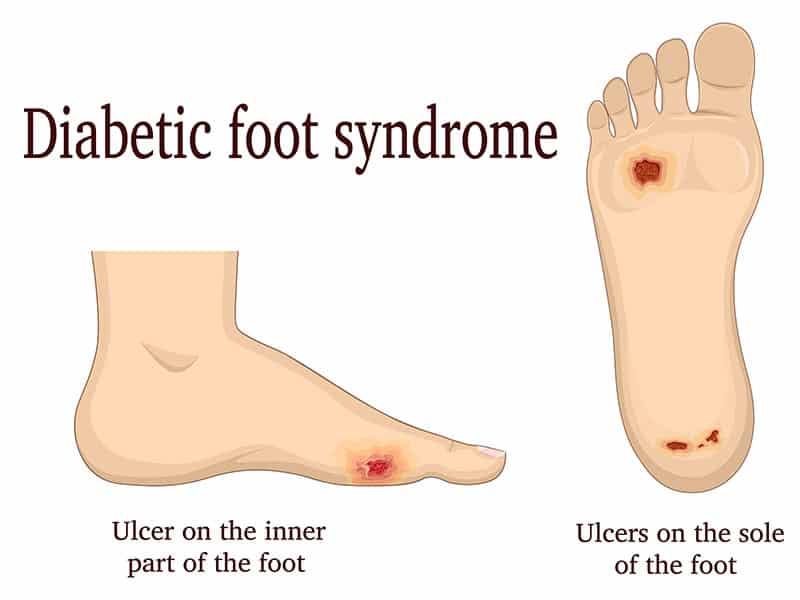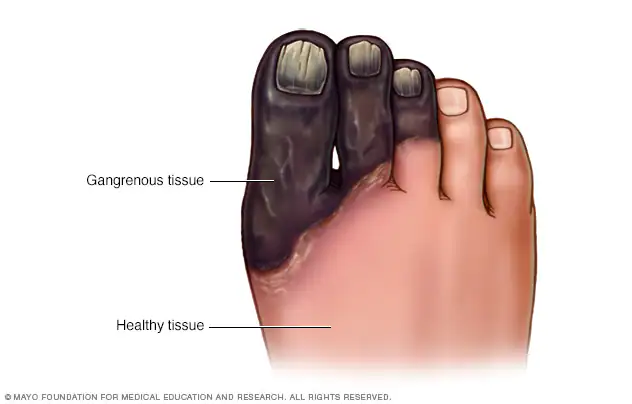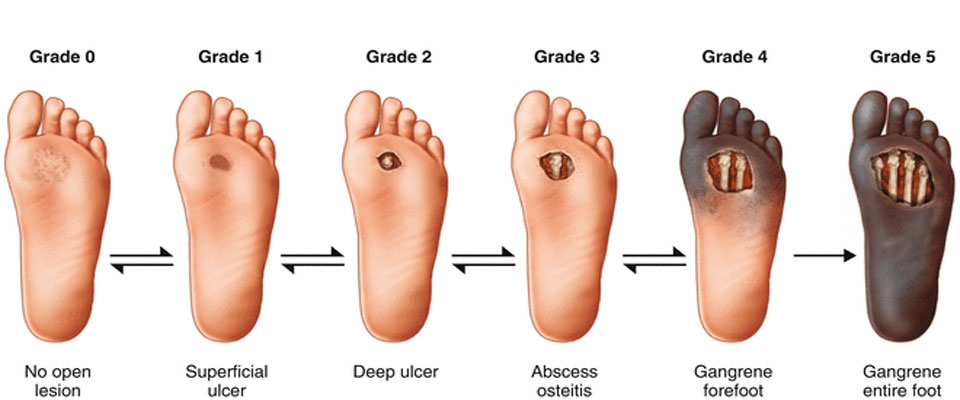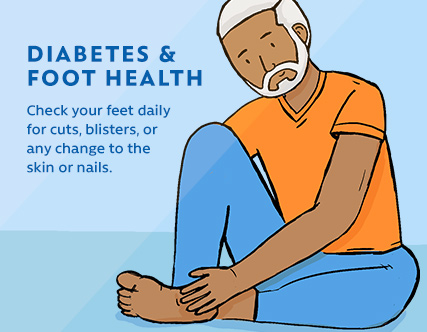Home » Diabetic Foot Treatment – Symptoms, Cost, and Care

If you have diabetes and experience numb feet sometimes, it’s not unusual.
Diabetic foot ulcers affect a whopping 15-25% of diabetic patients. It’s essential for you to be aware of pre-diabetic foot symptoms and the various diabetic foot treatment options so that you can seek medical help in the early stages.
In this article, we talk about what diabetic foot is, how it’s caused, the treatment cost in India, and GMoney loans for medical treatments, among other things. Read on to know more!
You might wonder, what does diabetes have to do with the feet?
People with diabetes have an increased blood glucose level, which leads to higher-than-usual blood pressure. Prolonged or uncontrolled diabetes can cause this high blood pressure to damage the nerves and blood vessels of your feet, leading to loss of sensation and injuries, referred to as diabetic foot.
Diabetic foot presents with symptoms like numbness, tingling, pain, or loss of sensation in the foot that can be hard to catch initially.
If you have diabetic neuropathy, that is, nerve damage due to diabetes, you might not realize when you get a foot injury, like a cut, ulcer, shoe bite, or blister.

Source: clancymedicalgroup
If these injuries are left untreated for a long period, lack of blood flow to your feet and generalized reduced immunity due to diabetes can cause severe infection in the area. If the infection worsens, the tissues and muscles of your feet begin to necrose, turning black.

Source: mayoclinic
If you’re unaware of or ignore the signs and symptoms of diabetic foot, the condition will likely progress and get more severe, possibly resulting in foot amputation.
The primary cause of diabetic foot pains is long-standing high blood sugar levels due to diabetes. If your blood sugar is high for long periods, you develop chronic high blood pressure, which damages the nerves and vessels of your feet.
However, diabetic foot ulcers or diabetic foot infections can be triggered by other factors in diabetic patients, like:
Sonia, 55 years
Shares how she coped with foot amputation, secondary to diabetes.
“It was hard to take my doctor seriously when he initially warned me about all the symptoms and preventative measures of diabetic foot. After having diabetes for almost 14 years, I was used to my condition. Even when I started experiencing foot numbness and ulcers, I didn’t pay much attention to it. I thought it would go away on its own. When I finally visited the doctor, my diabetic foot infection was already severe, and my foot was turning black. The doctor took some scans to check the extent of the infection and said that amputation was our only choice. While I was already devastated with the news, I could not even imagine how I would pay the medical costs of the treatment now.
That’s when the doctor suggested using GMoney to pay my medical bills. At first, it seemed too good to be true considering their hassle-free process and no-cost EMI benefit. But the process was genuinely very smooth, and I am grateful that a facility like this exists for healthcare payments now.”
Soham, 52 years
Shares the symptoms he experienced before foot amputation.
“I work as a clerk at an office, and by the time I go home at night, I’m too tired to care about most things. My diabetic foot symptoms started with corn on the sole of my big toe, which I would cut out myself. Soon, my big toe lost its hair and started turning slightly dark. There was pain and tingling in my toe, which made it hard for me to do my job well, so I went to see a doctor. He asked me if I could feel heat and cold changes in my feet, and I hadn’t noticed that I no longer could. I regret not being more aware of these little things I should have looked out for to treat the infection earlier. Lack of awareness has cost me my foot.”
If you have diabetes, you should look out for one or more of these symptoms of diabetes-related neuropathy or diabetic foot infection:
You should consult your doctor immediately if you notice anything abnormal about your foot health, like changes in the skin or toenails, cuts, bruises, or calluses.
When you visit your healthcare provider for a regular foot check-up or if you notice anything abnormal in your feet, the doctors will first ask you a series of questions to understand any symptoms you have been experiencing.
Using various tools, your doctor will examine your toes, feet, and legs for any signs of infection, redness, or numbness.
If your symptoms are consistent with diabetic foot ulcers, your doctor will then ask you to take scans like an MRI or an X-Ray so they can visualize the extent of your diabetic foot infection. In addition, they might take a small sample of your infected skin or any pus discharge, if present, and send it to the lab for testing to confirm your diagnosis.
If your diagnosis is confirmed, your doctor will brief you about the best treatment options for you. Let’s dive into what measures you can expect when treating diabetic foot in India.
Based on your medical assessment, your doctor might choose from various treatment measures to stop the progression of your diabetic foot infection.
Depending on how severe the infection is, your healthcare provider may ask you to take diagnostic tests like an MRI or an X-ray scan and might require you to be admitted to the hospital.
Your treatment plan will depend on your individual case and might involve consulting with a specialist foot doctor or a podiatrist.
Here is what you can expect from treatment procedures for diabetic foot ulcers. To treat your infection, your healthcare provider might:
If your infection has already progressed to the bone, your doctor might advise amputation of the affected area as a life-saving measure.
But, you might wonder about the cost of diabetic foot treatment in different cities in India.

Source: gujarathospital
Naturally, the cost of diabetic foot treatment will vary according to the severity of your infection and your doctor or hospital. However, on average, you can expect to pay anywhere from Rs. 10,000 to Rs. 5 lakhs for diabetic foot treatment in India.
| City | Cost |
| Pune | Rs. 40,000 to Rs. 70,000 |
| Bengaluru | Rs. 40000 to Rs. 90,000 |
| Gurgaon/Gurugram | Rs. 20,000 to Rs. 5,00,000 |
| New Delhi | Rs. 30,000 to Rs. 2,00,000 |
| Kolkata | Rs. 40000 to Rs. 60,000 |
| Chennai | Rs. 40000 to Rs. 60,000 |
| Indore | Rs. 70,000 to Rs. 5,00,000 |
| Noida | Rs. 30,000 to Rs. 2,00,000 |
| Mumbai | Rs. 20,000 to Rs. 5,00,000 |
This number is a broad range because it depends on several variables like whether you visit a private or a government hospital and whether or not a hospital stay is required.
The cost of care and medication for diabetic patients is already pretty high, and the added amount of this treatment can easily consume your savings.
So, instead, you can consider taking a loan or using no-cost medical EMI options like GMoney to pay for your treatment.
In a medical emergency, the last thing you want to worry about is money. You want to ensure your loved ones are safe and well cared for. With GMoney, you can rest assured as it provides: –
Quality Healthcare
GMoney makes quality healthcare accessible to all individuals. Now, you don’t have to worry about being financially prepared for a medical emergency or a large medical bill.
Instant disbursal
GMoney provides instant disbursals for medical treatments without collaterals and deposits money to the hospital on your behalf even before the treatment.
No-cost EMI
This money can later be repaid by you in a no-cost EMI scheme. This way, you can focus on your health and recovery, or the recovery of your close ones, and repay the medical amount in installments later.
Some other benefits of using GMoney include:
Nisha, 50 years
Treated her diabetic foot using Gmoney
“My experience with GMoney was very smooth. I received a call from their team within one hour of application, and my bills were cleared on the same day. My mediclaim would take 2-3 weeks to process my claim, and with support from GMoney, I could take care of my health without worrying about the finances”
Raj, 72 years
Got his diabetic foot treated with financial help from GMoney
“I was struggling to pay for my treatment after losing my job. I tried applying for financial assistance from various sources, but the process was long and tedious. A friend suggested that I try using GMoney. Without a second thought, I applied online and was pleasantly surprised when they called me within a few hours. They processed my application and paid for my treatment on the same day.”
In addition, working with GMoney has also benefited hospitals, as they can focus on treating patients without any payment liabilities.
Dr. Prakash Mehta
“Diabetic foot is a complex and potentially disabling medical condition, caused by complications of diabetes. It is a leading cause of hospitalization and amputation in people with diabetes. Treatment may include antibiotics, wound care, offloading or even surgical intervention. EMI and financing options are the need of the hour. It helps patients to choose better and more timely treatments. Happy that Kamaljeet Kaur from GMoney is collaborating with our center to provide patients with more financial flexibility.”
Dr. Praful Lokhande
“I collaborated with Shivkrishna from GMoney, while I was searching for financial help for my diabetic foot patients. Shivkrishna explained the process to applying for financing options. It was simple and hassle-free. I explained the same to my patients. Patients who couldn’t afford the treatments could now get the care they needed. This helped them choose better and timelier treatments, ultimately avoiding hospitalization and amputation. Thanks to GMoney’s financing options, patients received the care they needed without financial stress.”
If you are currently not experiencing any symptoms, you are a step ahead. You’re now aware of what signs to look out for to detect a diabetic foot infection early, and you know your treatment options. But what preventive measures can you take to reduce the risk of developing a diabetic foot ulcer?
The best thing to do for your feet, and to avoid complications of diabetes, is to control your blood sugar levels as advised by your doctor.
You should regularly check your sugar levels and blood pressure and take your prescribed medication responsibly.

Source: cdc.gov
Here are some other things you can do to prevent diabetic foot:
If you’re already experiencing symptoms of diabetic foot, you must visit your doctor as soon as possible.
1) Can diabetic foot be cured?
Diabetic foot cannot be cured. Diabetic foot is a serious condition that, if left untreated, can lead to amputation. However, with proper management and treatment, the complication and risk of amputation can be reduced. Many patients needlessly undergo amputations because of improper diagnostic and therapeutic approaches.
2) Can diabetic foot ulcers cause death?
Diabetic foot, when left untreated, can lead to serious life-threatening complications. The ulcers can become infected if not given any medication. These complications will further result in amputation or even death, in severe cases. Hence, it’s always important to keep a check on your feet for any injury and seek medical help.
3) When to amputate diabetic foot?
When all the treatment options have failed to heal the wound and prevent further infection or when there is a non-healing wound causing pain to the patient, that’s when amputation takes place. Amputation is necessary to prevent further consequences. However, early treatment and proper medication can prevent the need of amputation.
4) How does diabetic foot occur?
Diabetic foot occurs due to the damaging effects of high blood sugar levels on the nerves and blood vessels in the feet. There are several other reasons like: –
Patients with diabetes are advised to keep a check on their foot and seek prompt medical attention if they develop any wound or infection.
5) Are diabetic foot ulcers dangerous?
Yes, diabetic foot can be dangerous and also life-threatening in some cases, if not properly treated and managed. Without medication, diabetic foot ulcers can lead to severe complications like impaired mobility, amputation or even death.
6) Who can get diabetic foot symptoms?
Anyone with diabetes is at risk for diabetic ulcer symptoms. However, you’re at a higher risk if you have comorbidities or secondary conditions like heart problems or kidney problems. Being overweight and consuming alcohol or tobacco can also adversely affect your health.
7) How long does it take for the ulcer to heal?
Healing of diabetic foot ulcers can take anywhere from a few weeks to a few months, depending on the severity of your infection. Ensuring your blood glucose stays within normal limits is essential for faster healing.
Diabetic foot is a serious but common occurrence in patients with diabetes. Knowing the signs and symptoms, you can seek medical help before any severe infection sets in. Remember to properly care for your feet and conduct regular checkups to avoid unwanted health risks.
If you notice any symptoms of diabetic foot, visit your doctor at the earliest.
With a GMoney loan for medical treatment, you never have to worry about not having enough funds at the right moment in a medical emergency. Get in touch with us and register for GMoney today!
Disclaimer: THIS WEBSITE DOES NOT PROVIDE MEDICAL ADVICE.
Follow us
Reach us
Mumbai HO
GMoney Pvt. Ltd.
315, 215 Atrium,
Next to Courtyard by Marriott,,
A.K. Road, Andheri East,
Mumbai - 400093
Ph : +91 86570 00105, +91 72089 60444
Quick Links
Bengaluru
GMoney Technologies Pvt. Ltd.
Oyo Work Spaces, Umiya Emporium,
Opposite Forum Mall, Hosur Rd,
Koramangala, Bengaluru,
Karnataka 560029
Ph : +91 89717 34815
Delhi
GMoney Technologies Pvt. Ltd.
Berry Co Works, 1E/3,
Jhandewalan extension,
Next to jhandewalan metro station
gate no. 2 Barakhambha Road,
New Delhi, Delhi 110001
Ph : +91 97116 26832
Pune
GMoney Technologies Pvt. Ltd.
91 Spring Board, Sky Loft,
Creaticity Mall, Off, Airport Rd,
opposite Golf Course, Shastrinagar,
Yerawada, Pune,
Maharashtra 411006
Ph : +91 84250 28758
Chandigarh
GMoney Technologies Pvt. Ltd.
SCO no. 292,
First Floor, Sector 35D,
Chandigarh
Ph : +91 84279 82012
Jaipur
GMoney Pvt. Ltd.
CODESKK Civil Tower,121 122,
Pandit TN Mishra Marg,
Santhosh Nagar, Nirman Nagar,
Jaipur – 302019
Ahmedabad
GMoney Pvt. Ltd.
22nd Floor, B Block,
Westgate By True Value,
Nr. YMCA Club, SG Highway,
Ahmedabad – 380051
Hyderabad
GMoney Pvt. Ltd.
Dwaraka Pride,
Plot no. 4/1, Survey No. 64,
Huda Techno Enclave, Madhapur,
Hyderabad (Telangana) – 500081
Chennai
GMoney Pvt. Ltd.
DBS Business Center, 31A,
Cathedral Garden Rd, Badrikari, Tirumurthy Nagar, Nungambakkam, Chennai, Tamil
Nadu – 600 034
Mumbai HO
GMoney Pvt. Ltd.
315, 215 Atrium,
Next to Courtyard by Marriott,,
A.K. Road, Andheri East,
Mumbai - 400093
Ph : +91 86570 00105, +91 72089 60444
Bengaluru
GMoney Pvt. Ltd.
Oyo Work Spaces,
Umiya Emporium,
Opp. Forum Mall, Hosur Rd,
Koramangala, Bengaluru,
Karnataka - 560029
Ph : +91 72089 60444
Pune
GMoney Pvt. Ltd.
91 Spring Board, Sky Loft,
Creaticity Mall, Airport Rd,
Opp. Golf Course, Shastrinagar,
Yerawada, Pune,
Maharashtra - 411006
Ph : +91 72089 60444
Delhi
GMoney Pvt. Ltd.
Berry Co Works, 1E/3,
Jhandewalan extension,
Gate no. 2 Barakhambha Road,
New Delhi, Delhi - 110001
Ph :
+91 72089 60444
Chandigarh
GMoney Pvt. Ltd.
SCO No. 292,
First Floor, Sector 35D,
Chandigarh - 160022
Ph : +91 72089 60444
Ahmedabad
GMoney Pvt. Ltd.
22nd Floor, B Block,
Westgate By True Value,
Nr. YMCA Club, SG Highway,
Ahmedabad - 380051
Hyderabad
GMoney Pvt. Ltd.
Dwaraka Pride,
Plot no. 4/1, Survey No. 64,
Huda Techno Enclave, Madhapur,
Hyderabad (Telangana) - 500081
Jaipur
GMoney Pvt. Ltd.
CODESKK Civil Tower,121 122,
Pandit TN Mishra Marg,
Santhosh Nagar, Nirman Nagar,
Jaipur - 302019
Chennai
GMoney Pvt. Ltd.
DBS Business Center, 31A,
Cathedral Garden Rd, Badrikari,
Tirumurthy Nagar,Nungambakkam, Chennai,
Tamil
Nadu - 600 034
Pune | Mumbai | New Delhi | Kolkata | Chennai | Navi Mumbai| Bengaluru | Ahmedabad | Nagpur | Hyderabad | Jaipur | Lucknow | Bhopal | Bhubaneswar | Nashik | Indore | Ghaziabad | Kanpur | Amritsar | Vasai | Noida | Gurugram | Chandigarh | Ranchi | Cuttack | Thane | Kalyan | Jalandhar | Kolhapur | Visakhapatnam | Chakan| Greater Noida | Wagholi | Raipur | Panvel | Belgaum | Mohali | Bhiwandi | Talegaon | Coimbatore | Palghar | Mumbra | Sangli | Surat | Durgapur | Ludhiana | Kochi | Agra | Ahmednagar | Ajmer | Akola | Aurangabad | Baroda | Beed | Rewari | Patiala | Vellore | Ranjangaon | Nanded | Nellore | Panipat | Panjim | Madurai | Mysore | Mangalore | Korba | Mathura | Kalaburagi | Jalgaon | Kharar | Guwahati | Kollam | Jamshedpur | Gwalior | Saswad | Solapur | Varanasi | Salem | Sambalpur | Jodhpur | Hubli | Panchkula | Faridabad | Amravati | Ayodhya | Badlapur | Dehradun | Parbhani | Ujjain | Udaipur | Tiruchirappalli | Srinagar | Shimla | Secunderabad | Ratnagiri | Pandharpur | Ananthapuram | Buldhana | Hadapsar | Baramati | Chittoor | Darjeeling | Dhule | Fatehpur | Gandhinagar | Haridwar | Gorakhpur | Jhansi | Kanchipuram | Kartarpur | Kurukshetra | Pondicherry | Prayagraj | Bharuch | Bhusawal | Bathinda | Pathankot | Nandurbar | Niphad | Kolar | Ambala | Kota | Pendurthi | Jabalpur | Palwal | Bhilai | Bhiwani | Bilaspur | Patna | Rohtak | Phagwara | Malegaon | Vijayawada | Bikaner | Chiplun | Darbhanga | Roorkee | Bhor | Rajahmundry | Margao | Alwar | Dhanbad | Bulandshahr | Aluva | Mulshi | Davanagere | Kapurthala | Anantapur | Loni | Latur | Gondia | Chhindwara | Chandrapur | Dharmapuri-TN | Faridkot | Dharwad | Daund | Chaksu | Bareilly | Kakinada | Haldwani | Doddaballapur | Dindori-MH | Bagru | Kudus | Kozhikode | Gurdaspur | Bokaro | Berhampur | Batala | Barrackpore | Ramgarh | Meerut | Bassi | Dera Bassi | Howrah | Karjat Raigarh | Thiruvananthapuram | Bheemunipatnam | Ambegoan | Allahabad | Aligarh | Alappuzha | Tirupathi | Thoppumpady | Srikakulam | Siliguri | Rourkela | Mirzapur | Gadag | Bellary | Tumkur | Sonipat | Hoshangabad | Junnar | Jalna | Hisar | Karnal | Kottayam | Muzzafarnagar | Ramnagara | Thrissur | Bahadurgarh | Balasore | Baraut | Dhar | Ernakulam | Gadhinglaj | Chikodi | Vaniyambadi | Kamothe |